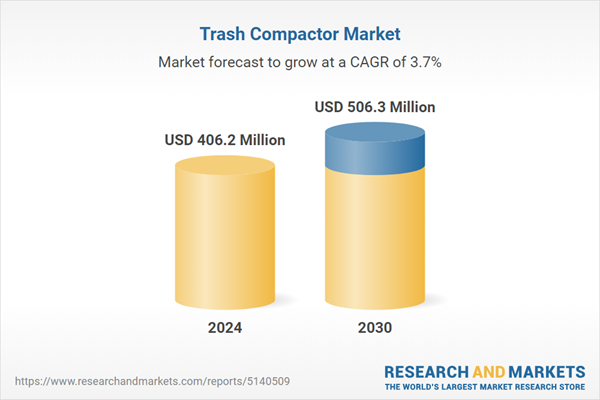The global market for Trash Compactor was valued at USD 406.2 Million in 2024 and is projected to reach USD 506.3 Million by 2030, growing at a CAGR of 3.7% from 2024 to 2030. This comprehensive report provides an in-depth analysis of market trends, drivers, and forecasts, helping you make informed business decisions.
Global Trash Compactor Market - Key Trends & Drivers Summarized
What Are Trash Compactors and Why Are They Useful?
Trash compactors are devices used to compress and reduce the volume of waste, making waste management more efficient and reducing the frequency of waste collection. These machines are commonly used in residential, commercial, and industrial settings. Trash compactors help save space, lower disposal costs, and minimize the environmental impact of waste by reducing the amount of waste sent to landfills. By compacting waste, these devices also contribute to more organized and hygienic waste management. The convenience and efficiency provided by trash compactors make them valuable tools for effective waste management.How Have Technological Innovations Shaped the Market?
Technological innovations have significantly influenced the design and functionality of trash compactors. Modern trash compactors are equipped with advanced features such as automatic sensing, odor control, and energy-efficient operation. The development of more robust and durable materials has enhanced the longevity and reliability of these machines. Innovations in hydraulic and mechanical systems have improved the compaction force and efficiency of trash compactors, making them more effective at reducing waste volume. Additionally, the integration of smart technologies, such as IoT connectivity and remote monitoring, has enhanced the convenience and usability of trash compactors, allowing users to manage and monitor waste disposal more effectively. These technological advancements have expanded the applications and appeal of trash compactors across various settings.Who Are the Major Users and What Are Their Needs?
The major users of trash compactors include households, commercial establishments, and industrial facilities. Households use trash compactors to manage domestic waste more efficiently, seeking compactors that are easy to use, safe, and effective at reducing waste volume. Commercial establishments, such as restaurants, hotels, and retail stores, use trash compactors to handle large volumes of waste generated by their operations, requiring robust and reliable machines that can operate continuously. Industrial facilities use trash compactors to manage waste from manufacturing processes, demanding high-capacity and durable compactors that can handle various types of waste. Each user group values trash compactors that offer efficiency, durability, and ease of maintenance.What Is Driving Growth in the Trash Compactor Market?
The growth in the trash compactor market is driven by several factors, including increasing waste generation, rising environmental awareness, and advancements in waste management technologies. The growing volume of waste generated by households, commercial establishments, and industrial facilities has increased the demand for efficient waste management solutions, driving the adoption of trash compactors. Rising environmental awareness and the need to reduce the environmental impact of waste have promoted the use of trash compactors to minimize waste volume and improve recycling rates. Advancements in waste management technologies, including the development of more efficient and durable compactors, have enhanced the appeal and functionality of these devices, supporting market growth. Additionally, government regulations and initiatives aimed at promoting sustainable waste management practices have further fueled the demand for trash compactors.Report Scope
The report analyzes the Trash Compactor market, presented in terms of market value (USD Thousand). The analysis covers the key segments and geographic regions outlined below.Segments
Product Type (Stationary Compactor, Self-Contained Compactor, Other Product Types).Geographic Regions/Countries
World; United States; Canada; Japan; China; Europe (France; Germany; Italy; United Kingdom; Spain; Russia; and Rest of Europe); Asia-Pacific (Australia; India; South Korea; and Rest of Asia-Pacific); Latin America (Argentina; Brazil; Mexico; and Rest of Latin America); Middle East (Iran; Israel; Saudi Arabia; United Arab Emirates; and Rest of Middle East); and Africa.Key Insights:
- Market Growth: Understand the significant growth trajectory of the Stationary Compactor segment, which is expected to reach $229.7 Million by 2030 with a CAGR of a 3.7%. The Self-Contained Compactor segment is also set to grow at 4% CAGR over the analysis period.
- Regional Analysis: Gain insights into the U.S. market, valued at $108.9 Million in 2024, and China, forecasted to grow at an impressive 5.8% CAGR to reach $102.1 Million by 2030. Discover growth trends in other key regions, including Japan, Canada, Germany, and the Asia-Pacific.
Report Features:
- Comprehensive Market Data: Independent analysis of annual sales and market forecasts in USD from 2024 to 2030.
- In-Depth Regional Analysis: Detailed insights into key markets, including the U.S., China, Japan, Canada, Europe, Asia-Pacific, Latin America, Middle East, and Africa.
- Company Profiles: Coverage of major players such as Broan, Inc., Electrolux AB, GE Appliances, Krushr, Viking Range LLC and more.
- Complimentary Updates: Receive free report updates for one year to keep you informed of the latest market developments.
Why You Should Buy This Report:
- Detailed Market Analysis: Access a thorough analysis of the Global Trash Compactor Market, covering all major geographic regions and market segments.
- Competitive Insights: Get an overview of the competitive landscape, including the market presence of major players across different geographies.
- Future Trends and Drivers: Understand the key trends and drivers shaping the future of the Global Trash Compactor Market.
- Actionable Insights: Benefit from actionable insights that can help you identify new revenue opportunities and make strategic business decisions.
Key Questions Answered:
- How is the Global Trash Compactor Market expected to evolve by 2030?
- What are the main drivers and restraints affecting the market?
- Which market segments will grow the most over the forecast period?
- How will market shares for different regions and segments change by 2030?
- Who are the leading players in the market, and what are their prospects?
Some of the 42 major companies featured in this Trash Compactor market report include:
- Broan, Inc.
- Electrolux AB
- GE Appliances
- Krushr
- Viking Range LLC
- Whirlpool Corporation
Table of Contents
I. METHODOLOGYII. EXECUTIVE SUMMARY2. FOCUS ON SELECT PLAYERSIII. MARKET ANALYSISIV. COMPETITION
1. MARKET OVERVIEW
3. MARKET TRENDS & DRIVERS
4. GLOBAL MARKET PERSPECTIVE
UNITED STATES
CANADA
JAPAN
CHINA
EUROPE
FRANCE
GERMANY
ITALY
UNITED KINGDOM
SPAIN
RUSSIA
REST OF EUROPE
ASIA-PACIFIC
AUSTRALIA
INDIA
SOUTH KOREA
REST OF ASIA-PACIFIC
LATIN AMERICA
ARGENTINA
BRAZIL
MEXICO
REST OF LATIN AMERICA
MIDDLE EAST
IRAN
ISRAEL
SAUDI ARABIA
UNITED ARAB EMIRATES
REST OF MIDDLE EAST
AFRICA
Companies Mentioned (Partial List)
A selection of companies mentioned in this report includes, but is not limited to:
- Broan, Inc.
- Electrolux AB
- GE Appliances
- Krushr
- Viking Range LLC
- Whirlpool Corporation
Table Information
| Report Attribute | Details |
|---|---|
| No. of Pages | 294 |
| Published | April 2025 |
| Forecast Period | 2024 - 2030 |
| Estimated Market Value ( USD | $ 406.2 Million |
| Forecasted Market Value ( USD | $ 506.3 Million |
| Compound Annual Growth Rate | 3.7% |
| Regions Covered | Global |









